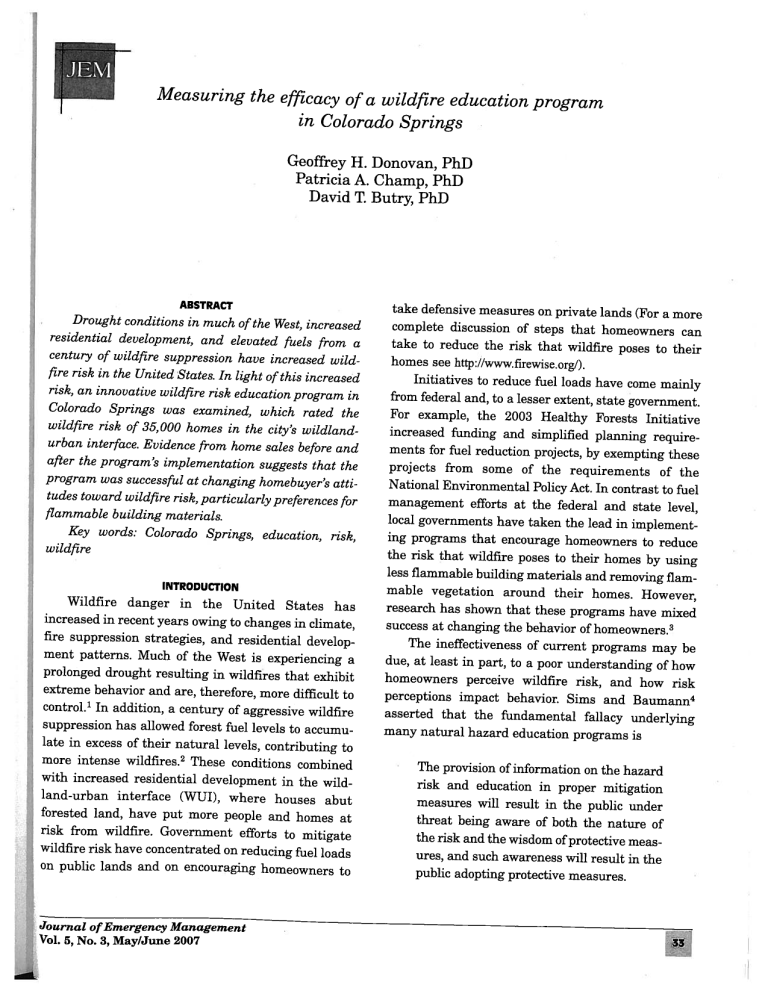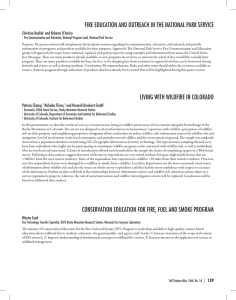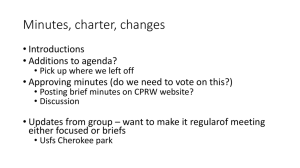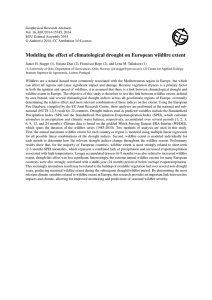in Measuring the efficacy of a wildfire education program Colorado Springs H.

Measuring the efficacy of a wildfire education program
in
Colorado Springs
Geoffrey
H.
Donovan, PhD
Patricia
A.
Champ, PhD
David
T.
Butry, PhD
ABSTRACT
Drought conditions in much of the West, increased residential development, and elevated fuels from a century of wildfire suppression have increased wild- fire risk in the United States. I n light of this increased risk, a n innovative wildfire risk education program in
Colorado Springs was examined, which rated the wildfire risk of 35,000 homes in the city's wildland- urban interface. Evidence from home sales before and after the program's implementation suggests that the program was successful a t changing homebuyer's atti- tudes toward wildfire risk, particularly preferences for flammable building materials.
Key words: Colorado Springs, education, risk, wildfire
INTRODUCTION
Wildfire danger in the United States has increased in recent years owing to changes in climate, fire suppression strategies, and residential develop- ment patterns. Much of the West is experiencing a prolonged drought resulting in wildfires that exhibit extreme behavior and are, therefore, more difficult to contro1.l In addition, a century of aggressive wildfire suppression has allowed forest fuel levels to accumu- late in excess of their natural levels, contributing to more intense
wildfire^.^
These conditions combined with increased residential development in the wild- land-urban interface (WUI), where houses abut forested land, have put more people and homes a t risk from wildfire. Government efforts to mitigate wildfire risk have concentrated on reducing fuel loads on public lands and on encouraging homeowners to take defensive measures on private lands (For a more complete discussion of steps that homeowners can take to reduce the risk that wildfire poses to their homes see http://www.firewise.org/).
Initiatives to reduce fuel loads have come mainly from federal and, to a lesser extent, state government.
For example, the 2003 Healthy Forests Initiative increased funding and simplified planning require- ments for fuel reduction projects, by exempting these projects from some of the requirements of the
National Environmental Policy Act. In contrast to fuel management efforts at the federal and state level, local governments have taken the lead in implement- ing programs that encourage homeowners to reduce the risk that wildfire poses to their homes by using less flammable building materials and removing flam- mable vegetation around their homes. However, research has shown that these programs have mixed success at changing the behavior of
homeowner^.^
The ineffectiveness of current programs may be due, a t least in part, to
a
poor understanding of how homeowners perceive wildfire risk, and how risk perceptions impact behavior. Sims and Baumann4 asserted that the fundamental fallacy underlying many natural hazard education programs is
The provision of information on the hazard risk and education in proper mitigation measures will result in the public under threat being aware of both the nature of the risk and the wisdom of protective meas- ures, and such awareness will result in the public adopting protective measures.
Journal of Emergency Management
Vol. 5, N o . 3, 2007
Although this may seem like an eminently sensi- ble approach to natural hazard education, research has often shown that it does not work.* How people estimate risk is a large and active area of research, and summarizing it is beyond the scope of the article
(For a good introduction to this area of research see
Slovic5). However, some general research findings in the area of risk perceptions may provide insight into why so many natural hazard education programs fail to change people's behavior. First, technical experts often disagree about the risk of natural hazards. With respect to wildfire risk, a homeowner would be hard pressed to find any information on the exact risk of losing his home to a wildfire. Furthermore, most people are uncomfortable making risk estimates of uncertain events such as
wildfire^.^
In consequence, people often employ simplifying heuristics to esti- mate the risk that natural hazards such as a wildfire pose to them. For example, Tversky and Kahneman7 found that individuals often base the probability of an event on the number of instances of such events in their memory. Individuals may have a hard time con- ceptualizing the risk of a large wildfire if they have not experienced one. They may think "there has never been a wildfire where I live so it is very unlikely that there will be one in the future." Psychologists have also found that individuals often discount informa- tion that does not support a chosen action and focus on information that supports their choice. In a similar manner, people often make ex post facto risk assess- ments of the type, "I have built a wood house in a dense forest; therefore, the wildfire risk must be low."
Individuals might also overestimate the value of risk mitigation actions they have taken and consider themselves safe from losing their home to a wildfire because they have cleared out nearby vegetation.
Another important finding is that people react very differently to risks they see as controllable versus uncontrollable. An example of a controllable risk might be cigarette smoking, whereas many people would view the risk of a nuclear accident as beyond their control. Furthermore, people are more likely to mitigate risk if they view it as under their control.
Interestingly, Winter and Fried8 found that homeown- ers in the WUI view wildfire risk as beyond their control, and that responsibility for managing wildfire risk, therefore, falls on land management agencies and not homeowners. This finding is consistent with studies of other natural hazards, which have found that homeowners believe government has a greater responsibility than they do for managing the risk posed by natural
hazard^.^
In addition, most home- owners are insured against wildfire losses, which fur- ther reduces the incentive to take mitigating action.
In light of the problems with current wildfire education efforts, we examine an innovative program implemented by the Colorado Springs Fire Depart- ment (CSFD). This program differs from others, because instead of providing general information on wildfire risk, it provides parcel-specific wildfire risk ratings. In addition, we present an alternative way of measuring program efficacy. Rather than simply measuring changes in risk perceptions, we examine the effect of the program on the housing market. This provides a more complete picture of how the CSFD approach to education affects homeowner attitudes toward wildfire risk.
STUDY AREA
Colorado Springs is a city of 361,000 on the front range of the Rocky Mountains in Colorado, approxi- mately 70 miles south of Denver. The CSFD was par- ticularly concerned by the risk that wildfire posed to a 45-square-mile area on the western edge of the city containing approximately 35,000 houses. This area is bordered by the Pike National Forest, the Air Force
Academy, and the Fort Carson Army Base. Average annual precipitation of 15 in supports a dry-type for- est of ponderosa pine and gambel oak with some
Douglas-fir at higher elevations. The area has a mixed-severity fire regime: fires can vary from ground fires that cause little or no overstory mortali- ty to severe stand-replacing fires. The 240,000-acre
Pikes Peak Ranger District, which borders the study area, experiences between 40 and 50 wildfire igni- tions in an average year. However, very few of these ignitions exceed 5 acres (C. Randall, oral commu- nication, December 14, 2004) because they are ordi- narily suppressed by fire crews or by the rain t h typically accompanies lightning. Since Europe
settlement, the area has experienced two major fires.
In 1854, a fire started approximately 7 miles south- west of downtown Colorado Springs on Cheyenne
Mountain and burned north through the area before turning west toward the town of South Park.
Although exact records are not available, the wildfire is believed to have burned several hundred thousand acres. In 1950, a wildfire started while land was being cleared for a golf course and resulted in nine firefight- er deaths, and 92 destroyed buildings.
The CSFD was concerned by the area's history of periodic severe fires, 50 years of fire exclusion, and a perceived public indifference to existing wildfire risk education efforts. They suspected that one reason for the ineffectiveness of wildfire education programs was that they typically provided general guidance; that is, information on wildfire risk and ways to reduce this risk was not property specific. Consequently, home- owners might regard wildfire risk as a large-scale problem, which would not be significantly affected by individual action. To counter this view, the CSFD implemented a program to provide parcel-specific wildfire risk ratings for the 35,000 homes in the city's WUI.
The CSFD developed an algorithm incorporating
25 variables to calculate a parcel's wildfire risk rat- ing: low, moderate, high, very high, or extreme. The
CSFD has not, however, made the algorithm public as they believed that the inevitable arguments about the weights given to different variables would distract m the goal of encouraging homeowners to reduce e risk that wildfire poses to their homes. Although to 25 variables were used, three variables largely rmine a parcel's wildfire risk rating. These are, in er of importance, construction material (roof and ing), proximity to dangerous topography (steep pes, ridges, etc), and vegetation density around a
The CSFD began the risk rating process in 2000, d on July 1,2002, they posted the parcel-level wild- sk ratings on the Web (http://csfd.springsgov.
.
Homeowners are able to access the wildfire rating of their house, or any other house, and ive information on how to mitigate wildfire risk. meowners take action to reduce the wildfire risk on their property, the CSFD will reassess their wild- fire risk rating. Since July 2002, the CSFD has con- ducted several thousand reassessments. The most common, and most effective, mitigation measure is to replace a wood shingle roof with a less flammable roofing material. On January 1,2003, a city ordinance came into force prohibiting the use of wood roofing shingles. Homeowners were not required to replace existing wood shingle roofs, but wood shingles could no longer be used for replacement roofs or new construction.
PROGRAM EFFICACY
The CSFD program has generated significant and sustained interest, as shown by the number of hits on the Web site, which have increased from an average of 676 per day in 2002 to 767 per day in
2005. Although the volume of visits to the CSFD Web site suggests that residents are interested in the program, interest may not translate into measurable action. To address the issue of whether providing the parcel level wildfire risk ratings on the Web site changed homeowners' attitude toward wildfire risk, we summarize the results of a recent study that estimated the effect of the program on the housing market in the Colorado Springs WUI.IO This study quantified the effect that attributes of a house (for example, number of rooms), its neighborhood (for example, school district), and its wildfire risk had on house price before and after wildfire risk ratings were made available. We do not replicate the full results here; instead, Table 1 shows the qualitative effect (positive, negative, or neutral) that wildfire risk, construction material, topography, and vegeta- tion density had on housing price pre- and post-Web site. Perhaps the most striking result in Table 1 is that pre-Web site wildfire risk and housing were positively correlated. In other words, houses with a higher wildfire risk had higher sales prices. The reason for this is that variables that increase a house's wildfire risk may be considered desirable by homebuyers. For example, Table 1 shows that pre- and post-Web site houses close to dangerous topography had higher sales prices. Although build- ing on a ridge may increase a house's wildfire risk, al of Emergency Management
5, 3, MayIJune 2007
I
Table 1. A comparison of the effect of wildfire risk, construction material, topography, and vegetation on housing price pre- and post-Web site*
1
Pre-Web site
+ Medium risk Neutral
+ Neutral
Very high risk + Neutral
Extreme risk + Neutral
1 wood roof
1
+
I
-
I
1
Wood siding
1
Neutral
1
-
I
Dangerous I
1 1 1
I
I
I topography
1 +
Vegetation
I
,
1 m*+ indicates positive effect on housing price.
1 negative effect on housina orice.
+
I
Neutral
1
Neutral
1
1
I it also provides better views. Results suggest that, for homeowners in Colorado Spring's WUI, better views outweigh the accompanying increase in wild- fire risk.
In contrast to pre-Web site, post-Web site home sale prices were not correlated to overall wildfire risk.
Changes in the effect of wood construction materials on house price account for this result: pre-Web site, a wood roof had a positive effect on price and wood sid- ing had no effect, whereas post-Web site, both had a negative effect on price. This result suggests that the
CSFD was successful at changing homeowners' pref- erences for homes at greater risk of wildfire, and that these changes were largely manifested through a shift in preferences away from wood construction materials.
DISCUSSION
In 2000 the CSFD undertook a unique program to rate the wildfire risk of 35,000 houses in that city's
WUI. Our results suggest that the program generat- ed significant public interest, encouraged mitigation efforts, and changed homeowners' preferences for flammable building materials. We hypothesize that the program succeeded, because it demonstrated to homeowners that they had control over their homes' wildfire risk. Not only did the program rate individ- ual wildfire risk on a simple 5-point scale, but it also provided homeowners with clear advice on how to reduce their homes' wildfire risk rating. Furthermore, if homeowners did mitigate, the CSFD would re-rate their home. Therefore, even though wildfire ignition and spread beyond their property are not under the control of homeowners, the program effectively com- municated the message that homeowners could reduce the risk of losing their home to wildfire by tak- ing mitigation measures.
The way in which the ratings are provided on the Web site may have also encouraged homeowners to take mitigation measures. The wildfire risk rat- ings are color coded, from green for low to red for extreme, and displayed on a map. Therefore, when homeowners look up the rating of their home, they will also see the ratings of neighboring homes. There is considerable variation among homes even over a short distance, so it is not uncommon for a house with an extreme rating to have a house with a low or moderate rating next door. This may encourage homeowners to take mitigation measures in tw ways. First, a homeowner may think that mitigatio measures will negatively impact the aesthetics their home by, for example, removing flammable trees and plants. If, however, a neighboring home with low risk still looks visually appealing, then this might allay some of their concerns. Second, research has shown that the way in which a person prepares for a natural disaster can be influenced by the choices made by others in the community. Therefore, if a homeowner sees that his or her neighbors have' lower risk ratings, then this may encourage the homeown- er to mitigate. Anecdotal evidence suggests the Web site sparked some level of "keeping up with the
Joneses" with respect to the undertaking of mitiga- tion measures to achieve a risk rating as low as the neighbor's.
The general lessons learned from the success o the CSFD program are applicable to other natura hazards. To be effective, a program should demon strate a link between individual behavior and risk.
Risk ratings at the individual level are one demonstrate this
link.
way to
Geoffrey H. Donovan, PhD, PNW Research Station, Portland, Oregon.
Patricia A. Champ, phD, ~ o c k y
Collins, Colorado.
David T. Butry, PhD, Southern Research Station, Research Triangle
Park, North Carolina. He is currently a t National Institute of Standards and Technology, Gaithersburg, MD.
REFERENCES
1. Calkin DE, Gebert KM, Jones JG, Neilson RP: Forest Service large fire area burned and suppression expenditure trends, 1970-
2002. J Forest. 2005; 103(4): 179-183.
2. Arno SF, Brown land fire. West Wildlands. 1991; 17(1): 40-46.
3. Beebe GS, Omi PN: Wildland burning: The perception of risk.
J Forest. 1993; 93(9): 19-24.
4. Sims JH, Baumann DD: Educational programs and human response to natural disasters. Environ Behav. 1983; 15(2): 165-189.
5. Slovic P: The Perception of Risk (Risk, Society, and Policy).
Sterling, VA: Earthscan, 2000.
6. Slovic P: Perceptions of risk. Science. 1987; 236: 280-285.
7. Tversky A, Kahneman DA: Availability: A heuristic for judging frequency and probability. Cogn Psycol. 1973; 5: 207-232.
8. Winter responsibility, and management strategies a t the wildland-urban interface. Soc Nut Resour 2000; 13: 33-49.
9. Slovic P: Informing and educating the public about risk. Risk
Anal. 1986; 6(4): 403-415.
10. Donovan GH, Champ PA, Butry DT: The impact of wildfire risk on housing price: A case study from Colorado Springs. Land Econ.
2007; 83(2): 109-124.
Vol. 5,
No.
MayIJune 2007





